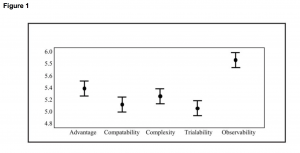Perceived Characteristics of E-cigarettes as an Innovation by Young Adults
Since their introduction to the US markets in 2007, e-cigarettes have gained widespread recognition. By 2009, a nationally representative survey reported that 16% of respondents had heard of e-cigarettes, and by 2013, a similar survey found that 86% of respondents had heard of these devices.
Looking at the history of the information environment surrounding e-cigarettes, we see that it has been very dynamic. The product ‘blu’ first dominated as the representation of the e-cigarette on TV from 2011-2013, and it is considered to be largely responsible for the initial spike in public awareness. At the same time, product websites began popping up, marketing videos sprouted across YouTube, e-cigarettes became a popular topic across social media platforms, and sales steadily expanded throughout the US. These advertisements depicted e-cigarettes as a healthier, environmentally conscious, and innovative replacement to traditional cigarettes that could be used anywhere without fear of ostracization. Previous studies found that interests in e-cigarettes, and the contents of their advertisements are compatible with the Diffusion of Innovation Theory, and this study provides a more nuanced view.
This 2015 study was conducted before the use of e-cigarettes among youths reached epidemic levels, and the FDA implemented heavy regulations. It looks toward the body of work on the Diffusion of Innovations to investigate the channels through which information about e-cigarettes flow, and the way in which the public perceives this device as an innovation. The Diffusion of Innovation Theory explains the process by which innovations are communicated through certain channels over time among members of a social network. This theory suggests that individuals with certain demographic and personality traits can be more or less likely to adopt an innovation, or be the first or last to do so, and it describes the characteristics of an innovation that influence an individual’s perception as they consider whether or not to adopt it. The five characteristics of innovation that influence the probability of adoption are relative advantage, compatibility, complexity, trialability, and observability.
This study observed the online survey results of a representative sample of young adults in the US (18-24), and measured their perception of e-cigarettes as an innovation, as well as their channels of information exposure. Ultimately, they found the leading factors influencing the image of e-cigarettes as a favorable innovation were observability and relative advantage. Observability explains the degree to which members of the social network may see the results of adopting the innovation, and relative advantage describes the ways that an innovation is superior in achieving the same outcome. The observability of e-cigarettes is promoted through celebrity appearances in movies, shows and advertisements, and their relative advantage over cigarettes is based upon the narrative that they are a healthier, environmentally conscious and more socially acceptable alternative. Furthermore, the advertisements that most strongly and consistently targeted the five characteristics of innovation were found in magazines, in-person and in-store channels. Previous studies have found a diversity of channels through which information about e-cigarettes is spread, but the role of interpersonal contact was always strong. This channel of diffusion is very similar to the examples of diffusion among densely connected components that we modeled in class.
Overall, the study found this information exposure to predict a positive appraisal of e-cigarettes as an innovation, and this marketing has been successful in getting the product to reach its ‘first phase of acceptance’. They posited that the product’s perception as an innovation will continue to persuade the public, and that improvements to design, as well as the addition of flavors, will allow the product’s compatibility to catch up to its relative advantage and observability. They hypothesized that this transition will allow e-cigarettes to reach the 15%-25% adoption rate needed for a product to ‘take-off’ under the Diffusion of Innovation Theory. This article supported marketing regulations for e-cigarettes due to their unknown health risks, and reflecting on the current e-cigarette epidemic, perhaps this paper should have received more attention.
Source: https://www.ncbi.nlm.nih.gov/pmc/articles/PMC4341835/#R20

